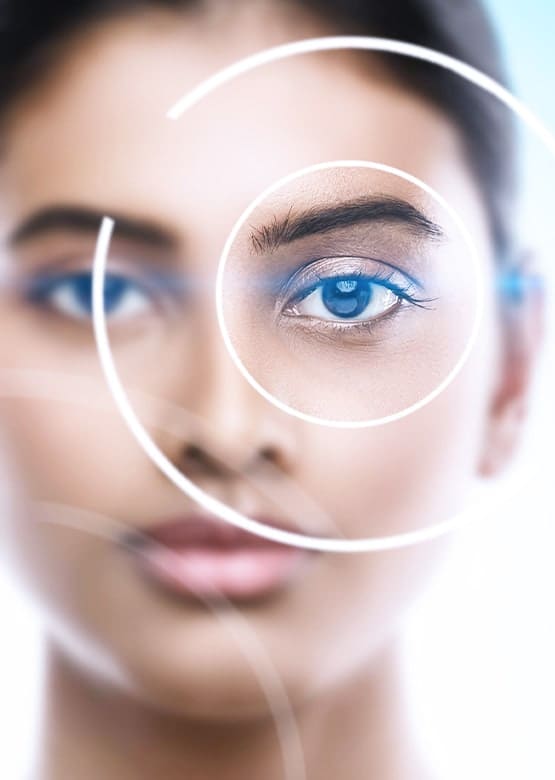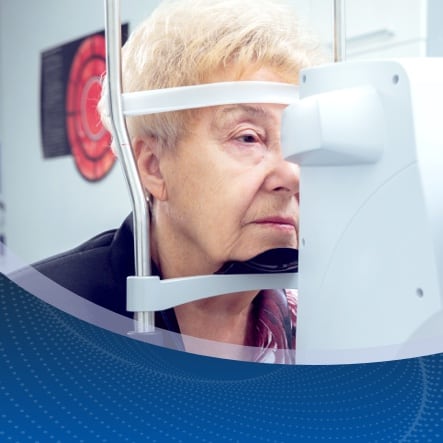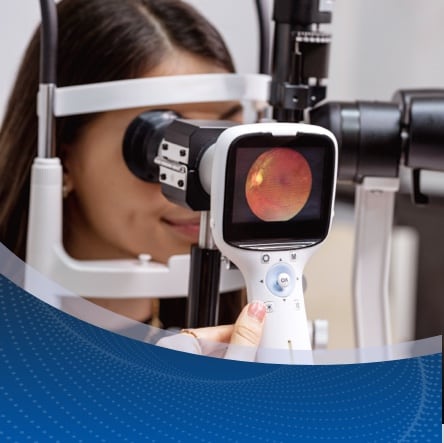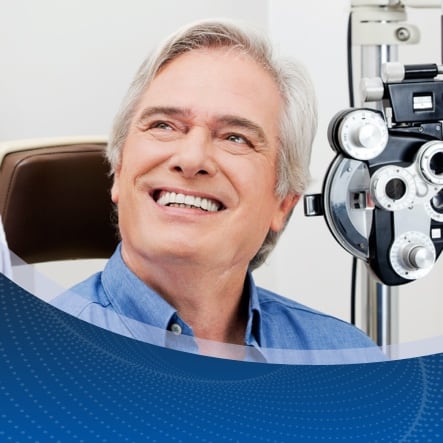

Who Is a Good Candidate for LASIK?
Patients interested in LASIK eye surgery in Chesapeake must meet specific criteria to ensure the best results. Our experienced ophthalmologists will assess your eyes and recommend the most suitable treatment plan. To determine whether you’re a good candidate, a consultation with Dr. Paul Griffey prior to surgery is important to determine your estimated benefits of LASIK and any possible complications.
After the evaluations and discussion, your ophthalmologist will determine whether you’re a good candidate. Generally, a good candidate for LASIK will have met the following conditions:
- You are at least 18 years old
- Your corneas are healthy & appropriately thick
- Your overall eye health is good
- Your prescription hasn’t significantly changed within the last year
Your refractive error can be treated with LASIK (astigmatism, myopia, hyperopia)
Choosing LASIK surgery in Chesapeake, VA, can offer the exciting possibility of reducing or eliminating your dependence on glasses or contact lenses. With LASIK, 90% of patients can achieve between 20/20 and 20/40 vision. The first step to enhancing your vision is a consultation to see if LASIK may benefit you.
Contact Griffey Eye Care & Laser Center for a LASIK consultation.
Frequently Asked Qestions about LASIK
What is a Refractive Error?
In normal vision, light enters the eye through the cornea and is focused at a single point on the retina at the back of the eye. With a refractive error, there is a defect in the way light passes through the eye.
What is Laser Vision Correction?
Performed since the early 1970’s, laser vision correction procedures improve vision for people with nearsightedness, farsightedness and astigmatism. Laser assisted In-Situ Keratomileusis, or LASIK, is an excellent technique for reshaping the surface of the corneas to correct these common vision problems. The goal of surgery is to reduce or eliminate the need for glasses and contact lenses.
What is Laser Light?
Lasers use light beams that are made from a single color or wavelength of light and which have all of the light rays traveling in the same direction (coherent light). Laser light is not radiation, as are x-rays, cosmic rays and gamma rays. The light itself is safe and does not become effective in medical treatment until it becomes highly concentrated through the use of special mirrors and lenses. Laser light reaches its maximum strength at the focal point, the point where all the rays converge. The strength of the beam rapidly diminishes after passing the focal point, and can no longer affect other tissues in the eye.
What is the Excimer Laser?
Instead of using heat to alter tissues like other lasers, an excimer laser beam breaks the bonds that link tissues together with only minimal effect on surrounding tissues. These unique properties allow the excimer laser to be used in the LASIK procedure to reshape corneal tissue. After LASIK, light rays focus more precisely on the retina.
What is the LASIK procedure?
A special instrument, called a microkeratome, is applied to the cornea creating a thin flap of corneal tissue. The flap remains attached to the eye at one end. Next, the laser is used to reshape the cornea. A computer, programmed by the doctor for each person’s own correction factors, controls the laser and the reshaping of the corneas.
The procedure is performed while the patient lies on his/her back. In treating myopia the laser segment of the procedure starts with a narrow diameter beam. As the laser beam expands or moves, a tiny lens-shaped disc is created. The focal point of the beam only penetrates the cornea about two-thousandths of an inch (about half the thickness of a human hair). Only a small area in the center of the cornea is treated, essentially producing a concave lens over the visual axis. Finally, the corneal flap is replaced (without stitches) and the LASIK procedure is complete. The flap is then replaced and allowed to heal. No stitches are necessary.
What Should I Expect After LASIK?
Many patients who undergo LASIK eye surgery in Chesapeake report being able to pass a driver’s license test without corrective lenses and enjoy improved vision clarity. Many patients report an immediate improvement within the first day. For others, vision may be blurry during the healing period.
Since an individual’s situation, healing powers and tissues are unique, not everyone should expect to achieve full visual correction. People with high to severe levels of myopia or astigmatism may require another procedure to achieve the desired results. People with extremely strong glasses for example, may end up with significant corrections, but still need mild to moderate strength lenses part of the time for some activities.
Is LASIK an Outpatient Surgery?
Yes, LASIK is done on an outpatient basis. An eye drop anesthetic is used to numb the eye for painless surgery. LASIK normally takes less than 30 minutes and the patient leaves shortly after the procedure. An eye patch may be placed on the eye for temporary protection and to keep you from rubbing your eye in your sleep. Medication drops are used for pain relief, to prevent infection and promote healing. After LASIK, patients usually return to their normal lifestyle quickly with very few restrictions during the short healing period.
Get Started Today
Laser eye surgery can be exciting, but it’s also okay to be nervous! Your eye care provider is available to discuss your concerns and talk you through the process.
Ready to explore your options for vision correction surgery in Chesapeake? Request an appointment today to discover whether LASIK is right for you.
Our Locations
Our Testimonials
I recently went to my family doctor for pain I’d been having in my eye that was moving down my neck. I’d been waiting to have an MRI scheduled, and it was taking forever. I wanted to get a second opinion about what course of action should be taken. My husband and daughter are both patients at this practice and have always received stellar treatment. Dr. Griffey took very good care of me and went the extra step to send a letter to my family doctor while I was still there to concur with what they had said and also confirm that he would suggest an MRI as well. I was very impressed with him and his patient care. And, I appreciate the staff (particularly Tara and Benita) in scheduling me in as soon as possible. I would highly recommend this practice! Thank you all again for your help.
Beth K
I was referred to Dr. Griffey by several people. I was told he was an excellent ophthalmologist, and they were right. This was my first time meeting him and he made me feel so safe, comfortable and confident that he was providing me with the best and most knowledgeable treatment I could ask for. As I sat in the chair, I observed him interact with a baby he kissed on the forehead, it was so special to see him do that because it showed a gentle side of him, and his interaction with his assistants was nice, professional and straight to the point of what he needed in order to help his patient, I remember him saying to one of them that he was not going to let me leave until he reviewed a report from another doctor about my condition and that really made me feel special because it showed his concern. I don’t think I could have asked for a better doctor. Thank you Dr. Griffey for being the best and hats off to your father and grandfather.
C. Blount
I had a wonderful first appointment. The staff is attentive and the techs and doctors are knowledgeable and take their time really getting to know their patients. So happy to have found them.
M. Catherine
I travel from Atlanta, Georgia to see Dr. Griffey, MD, and board certified Ophthalmologist. Dr. Griffey has performed two surgeries on me and I would trust him to do anything he deems necessary. The staff is fantastic and I would recommend Dr. Griffey, to all that needed to see a competent Ophthalmologist!!!
M.Bailey Buck
I want to thank everyone at Chesapeake Eye Care for their care on a recent visit. I had an accident involving my eye and even though they were booked, the receptionist worked me in that day. The technician and Dr. Fox saw me promptly and performed a thorough exam. I was very pleased with both of them and appreciated their kindness and professionalism.
P. Brangan
My dad had cataract surgery a couple years ago. I was a little nervous for him, he’d been resisting getting surgery for so long. However, the staff and Dr. Griffey were wonderful to him and everything went very smoothly. He had a great experience, and I am thankful to them for making him so comfortable.
K. Kroll
The best thing I ever did was get LASIK surgery; it is unbelievable how I can see 20/20. When I get in bed at night I still think … wait….no, I don’t have to take my contacts out and it’s been 3 months. It was wonderful in Mexico also with not having to worry about contacts and all the solutions to bring with me. I had an amazing experience with my LASIK surgery with Dr. Paul Griffey and his staff! I would definitely recommend him to friends and family!!!
E. McConnell
I sent my mom to Dr. Griffey for a 2nd opinion on her eyes. Years later, I am still satisfied with the care he has provided. She had an appointment today and Dr. Griffey called me personally to discuss my concerns. WOW!!!!! GREAT PROVIDER!!!!!! I also referred my dad to him after a bad cataract surgery elsewhere. Dr Griffey did his 2nd eye without complications. THANK YOU for taking care of my parents! I have 30+ years in the business as a licensed optician and have worked with many doctors, I would recommend Dr. Griffey to any patient for care!!!!!!!!!!
Selena Cabral
I have been a patient of Dr. Griffey, since 2012. I’m born, raised, formal education, retired Law Enforcement, City of Virginia Beach, VA. After moving to Atlanta, I felt I could not find the care I needed, so I travel back and forth to receive my care. I will not allow anyone to see me. Well worth the trip, and will continue to do so!
Thank you for being The Best…
MBB
We both underwent cataract surgery, in both eyes. Barbara’s was in September of 2018. Mine was in December 2018. We both had excellent experiences, from her first visit, to my last. Dr. Griffey, as well as everyone on his staff, (that we came in contact with), were prompt and very professional. Yet, at the same time they were relaxed and very friendly. We were very impressed that everyone, asked, if we had any questions.
And, we can both see 20/20 again!!.
There was an general atmosphere of confidence and calmness throughout his practice, as well as within the Chesapeake Surgical Center. That made us both feel very comfortable, and well cared for. We have never before experienced such a well run practice. We have, (and will continue to), highly recommend Dr. Griffey to anyone who needs eye care.
Barbara and Eddie
CHECK US OUT ON SOCIAL


We are a proud partner of US Eye, a leading group of patient-centric, vertically integrated multi-specialty physician practices providing patients with care in ophthalmology, optometry, dermatology and cosmetic facial surgery.









